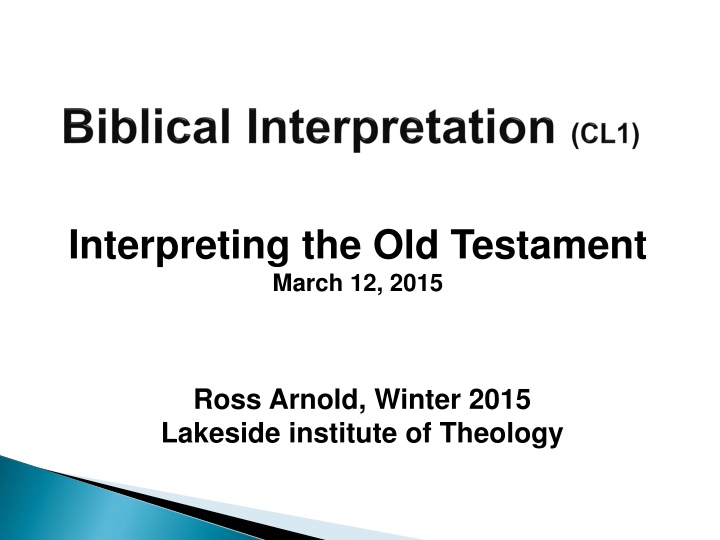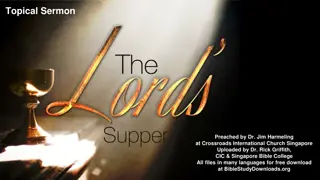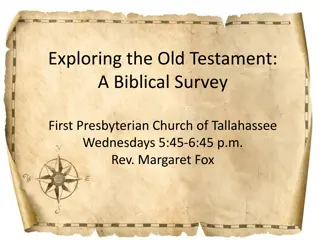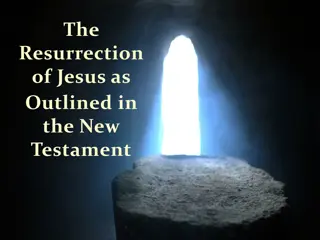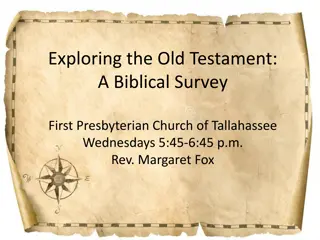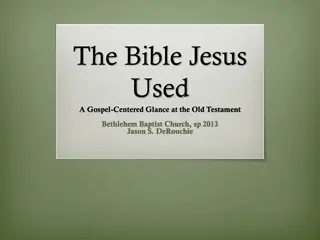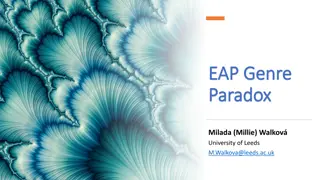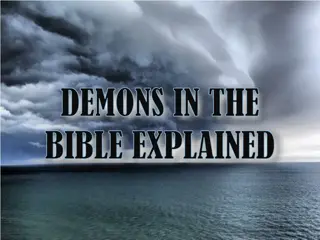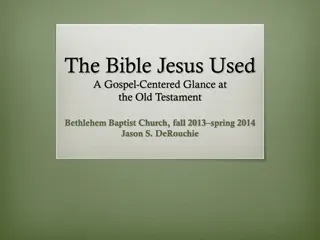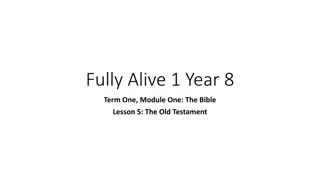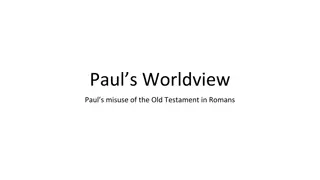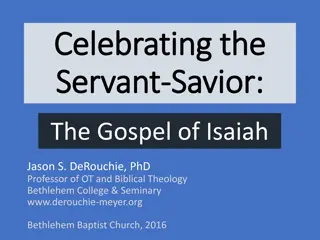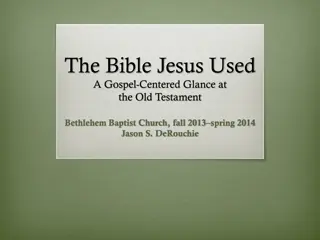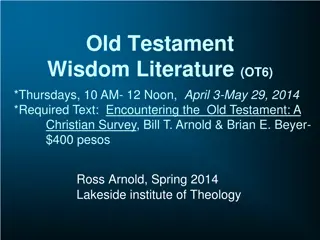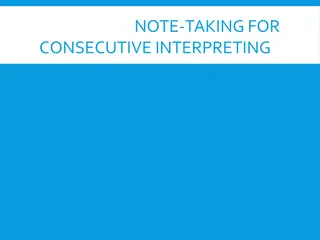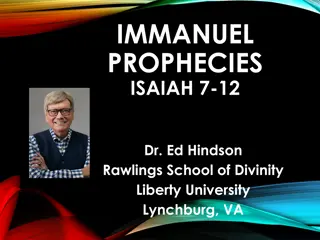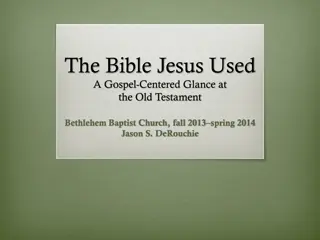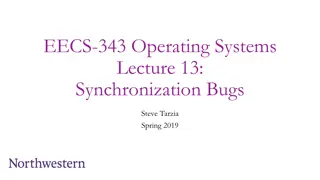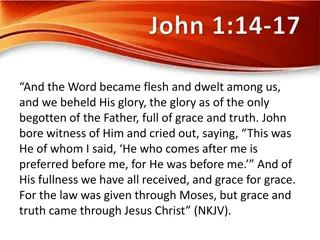Interpreting the Old Testament Genres
The process of interpreting the Old Testament involves understanding various literary genres found within its pages. Recognizing and properly interpreting these genres is crucial for grasping the true meaning and intent of the biblical text. Historical narrative, a significant genre, comprises a large portion of both the Old and New Testaments, presenting factual events with specific purposes that may not always be immediately clear. Context, repetition of words, and trustworthy characters within historical narratives provide essential clues for interpretation.
Download Presentation

Please find below an Image/Link to download the presentation.
The content on the website is provided AS IS for your information and personal use only. It may not be sold, licensed, or shared on other websites without obtaining consent from the author.If you encounter any issues during the download, it is possible that the publisher has removed the file from their server.
You are allowed to download the files provided on this website for personal or commercial use, subject to the condition that they are used lawfully. All files are the property of their respective owners.
The content on the website is provided AS IS for your information and personal use only. It may not be sold, licensed, or shared on other websites without obtaining consent from the author.
E N D
Presentation Transcript
Interpreting the Old Testament March 12, 2015 Ross Arnold, Winter 2015 Lakeside institute of Theology
Biblical Interpretation (CL1) Jan. 29 Introduction to Biblical Interpretation Feb. 5 Starting with the Text Feb. 12 Questions of Meaning Feb. 19 Principles of Interpretation Feb. 26 No Class Mar. 5 Interpreting the New Testament Mar. 12 Interpreting the Old Testament Mar. 19 Applying the Principles; Final Exam
Biblical Interpretation: the process of finding the purpose, meaning and right application of a passage of Scripture through a study of the cultural, geographic and historical context of the original writers and audiences; literary genre and forms; textual sources and variants; language structure, word meanings and grammar; and theological harmony within Scripture. To interpret a document is to express its meaning through speaking or writing. To engage in interpretation assumes there is, in fact, a proper and improper meaning of the text and that care must be taken not to misrepresent the meaning. When dealing with the Scriptures, to properly interpret a text is to faithfully convey the inspired human author s meaning of the text, while not neglecting divine intent. Robert L. Plummer
The Bible contains many genres (literary types characterized by particular style, form or content) that must be recognized to interpret the text properly. Misunderstanding the genre of a book (or passage) can lead to a skewed interpretation. Intentionally mislabeling a genre has sometimes been an underhanded way to deny the text s truthfulness. Genre interpretation has sometimes been misused to excuse one from the demands of Scripture. Christian scholarship is the human race s prodigious invention to defend itself against the New Testament, to ensure that one can continue to be a Christian without letting the New Testament come too close. Soren Kierkegaard
There are some genres found in both the Old and New Testaments: Historical Narrative the recounting of factual events, making up about 60% of the Bible, both OT and NT. It is often not obvious what the purposes are for the authors of biblical historical narrative, so it is more difficult to get at author intent. (An interpretive technique: I, (author), have told you this story because ) Context is especially important for interpreting historical narrative. Editorial comments within the test often can be guides to author purpose. Repetition of words or concepts is often a way for biblical authors to tells us what they want emphasized. Trustworthy characters often appear in historical narrative, to tell us more clearly what is right and what the main message is.
Some genres found in both the Old & New Testaments: Prophesy has various meanings, but most basically is the delivery of a message from God (a Spirit-inspired utterance ) through an appointed prophet, both in the OT and NT. Make sure you investigate the books background, date and author. When was it written, and what were the circumstances? To whom was it addressed, and what do we know of them? What do we know about the author? Context is also important for interpreting prophetic writing. Figurative language, including poetry and exaggerated expressions, is to be expected in prophesy and in modern translations are often set off in poetic lines. Conditional and unconditional prophesy that is, the statement of the unalterable purposes of God versus conditional consequences or warnings, must be distinguished from each other.
Some genres found in both the Old & New Testaments: Prophesy has various meanings, but most basically is the delivery of a message from God (a Spirit-inspired utterance ) through an appointed prophet, both in the OT and NT. Considering the implications for us today may help you see the intentions of the original prophetic author. Consider whether the prophetic predictions were fulfilled or are as yet unfulfilled. Take special note of the apologetic nature of prophetic writing. Understand the difference between Old Testament-era and New Testament-era prophesy.
The authors of Scripture understood themselves and their task as occurring in the context of community, and so must be interpreted in this light. Biblical authors assumed a continuity in God s dealing with his people, so that earlier events are seen as clearly foreshadowing of later ones. The New Testament authors understood themselves as living in the age of eschatological fulfillment. The New Testament authors believed all Scriptures were about Jesus Christ, as he was the fulfillment of all that had come before.
Some genres found in both the Old & New Testaments: Apocalyptic Literature writing (such as Daniel and The Book of Revelation) which reveals or unveils God s plans, especially by use of symbolic and/or mysterious imagery. Characteristics of Apocalyptic Literature may include: A clear expectation of God breaking into the present age to initiate a qualitatively different existence in the age to come. The use of an angelic mediator or mediators to communicate God s messages. A journey by a chosen human into the heavenly realms. Symbolic visions or dreams that describe both current and future spiritual realities and divine interventions. Visions of final, divine judgment. Warnings to the faithful or coming distresses and trials. Encouragement to the faithful to persevere until God intervenes.
Old Testament interpretation can be more complex than New Testament interpretation, simply because we are further away from the events and the culture. We must first focus on what the old Testament passage meant to those living in Old Testament times the original recipients. Identify the basic theological principle or principles reflected in the passage. Consider how this theological principle{s} fit into the rest of the Bible. Determine how we might read this Old Testament passage through the grid of the New Testament.
Narrative (stories) comprise nearly one-half of the O.T. Narrative has sequential time action, plot, setting and characters it is the story form of literature. The meaning of a narrative derives primarily from the action of the characters. Rather then telling us how to live or not live, the narrative shows us by the actions of the characters and the consequences. Old Testament story narrative is much more than history. It tells us the truth, but the deeper truth is theological. It is theological history, in narrative form. God uses narrative to teach us (rather than essays or some other form) because it is more interesting; we are drawn into the story; it depicts real life that we can relate to; it can better portray ambiguities and complexities of life; it s easier to remember; it can relate shorter incidents and events to the bigger story.
OT Narrative is not always clear (especially to Western minds), and so takes some interpretive work. It s possible to lose the real meaning by getting wrapped up in the story. (Why are we being told this story?) It is possible to miss the theological importance of the story. (What are we to learn from this story?) It is possible to read too much theological importance into an OT story.
Law occurs throughout much of the Old Testament, but is especially present in the Pentateuch. There are 613 mizvot, or commandments in the Old Testament. The challenge for us is to determine which ones still apply to us as Christians. The Traditional Approach has been to differentiate between moral, civil and ceremonial law in the Old Testament, with only the moral law still binding. It is also possible to interpret commandments according to Narrative Context. Or we may interpret commandments according to the Covenant Context reading the Mosaic Law through the grid of the New Testament.
Proverbs are a subset of Wisdom Literature a broad genre in which the reflections and sayings of the wise are recorded. Biblical proverbs differ from other kinds of proverbs in that they are divinely inspired, and so reflect what God approves of or condemns. But even biblical proverbs (except those that refer to God s nature) are circumstantial, and so allow for and even generally assume the possibility of exceptions. Therefore most biblical proverbs (along with the rest of wisdom literature) must be read as helpful guidance, but not as absolute promises.
Poetry occurs within many other Bible genres, and predominate the Psalms and Song of Songs. Hebrew poetry has very little that resembles Western poetry especially no rhyme or recognizable meter. Rather then being poetry of sound, Hebrew poetry (while it does use repeated syllables, lines, sounds and stress patterns almost none of which translate into other languages), is best understood as poetry of the mind built on imagery and ideas. Poetry is intended to makes the words more memorable, or to express and/or evoke strong emotions, Therefore we should expect figurative and exaggerated language which often cannot be taken literally. The question must be asked of Hebrew poetry What did the inspired author intend to communicate? It is important to be able to recognize Hebrew poetic forms parallelism (synonymous, antithetical and synthetic), X,X+1 structure, repetition of words or sounds, acrostic, chiasm.
Psalms, which is the worship songbook of the Hebrew people, is part of the large poetry genre but deserves its own attention. There are many subgenres of Psalms, but seven major ones: Psalms of Lament the most widespread subgenre, these are songs of mourning and distress, directed to or about God. Praise Psalms these praise God as Creator, Savior of Israel or Sovereign over history. Thanksgiving Psalms thanking God for answering petitions. Celebration Psalms to celebrate God s covenant relationship with his people. Wisdom Psalms a hybrid of song and wisdom literature, dealing with the source of true wisdom, dealing with injustice, etc. Penitential Psalms confess sin and declare repentance. Imprecatory Psalms calling on God to enact justice against the psalmist s enemies.
Guide to Interpreting the Psalms Note the organization of the Book of Psalms. The longest book in the Bible, containing 150 psalms, it is helpful the Psalms were divided into five books (perhaps in imitation of the Pentateuch): Book 1: Psalm 1-41 Book 2: Psalm 42-72 Book 3: Psalm 73-89 Book 4: Psalm 90-106 Book 5: Psalm 107-150 Focus on reading the Psalms themselves, rather than the mountain of introductory materials and commentary. Identify the subgenre of the psalm the best way to understand author intention. Then look at other psalms of the same subgenre type. Note superscriptions and other contextual information. Pay attention to how the psalm is structured & segmented.
Guide to Interpreting the Psalms Recognize the poetic language and symbolism used in the psalm. Explore any messianic significance reflected in the psalm. Pray the psalms. Memorize the psalms. Sing the psalms.
